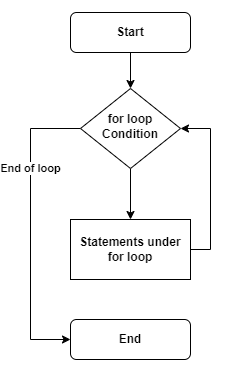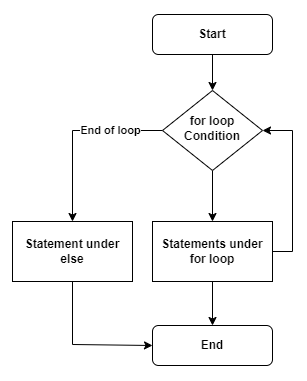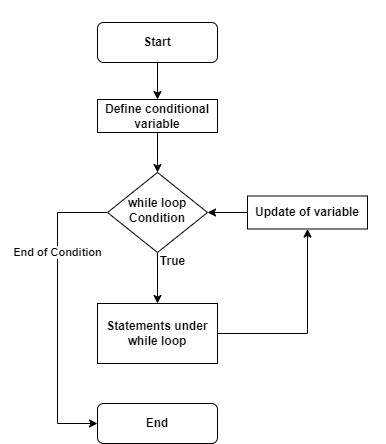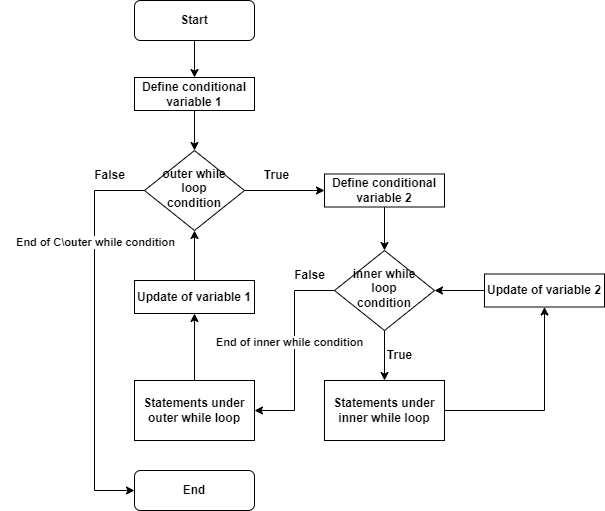Loops in Python are a fundamental concept that allow you to execute a block of code multiple times. In program logic, there comes multiple scenarios where we need to iterate over all the elements of a collection datatype. Those iterations over a collection can be done using loops.
Loops in Python
Python supports two types of loops: for loop and while loop
for loop
for loop in Python is used to iterate over a elements of a collection sequence (list, tuple, string, set, dictionary or other iterable objects). for loop allows to execute a block of code repeatedly for each element in the sequence. We can also use conditional statements, operators within that block of code.

for variable in sequence:
# Code block to executevariable–forloop variable takes the value of the current item in the sequence.sequence– This is the iterable sequence to iterate over. This sequence can be a collection datatype, string.
for loop Example
course_list = ['Python', 'AWS', 'Java', 'Azure', 'Data Science']
for course in course_list:
print(course)for loop with range() method and if statement
for number in range(10):
if number % 2 == 0:
print(number)range() method generates number from 0 to the given number. Using for loop we are iterating over the range of numbers and execute the code block for each number. if condition checks for remainder when number divided by 2 and if remainder is 0 then print that number.
Program Output
0
2
4
6
8for loop with string
for letter in "shbytes":
print(letter)s
h
b
y
t
e
sfor loop with dictionary
print("dictionary iteration")
courses = {"c1": "Python", "c2": "AWS", "c3": "Azure", "c4": "Java"}
for key in courses:
print("key - ", key, "value - ", courses[key])In this program, we have defined a dictionary courses. Dictionary elements are key-value pairs. Using for loop we are iterating over the dictionary elements. We will get the key of each dictionary element and courses[key] we get the value of that key.
Program Output
dictionary iteration
key - c1 value - Python
key - c2 value - AWS
key - c3 value - Azure
key - c4 value - JavaIn the similar way, we can iterate over other collection datatypes like Tuple and Set.
for loop with else statement
An else block can be used with a for loop. The code in the else block runs after the loop completes its iteration, unless the loop is terminated with a break.

for variable in sequence:
# Code block to execute
else:
# Code block for elseforloop will iterate over the sequence and will execute the code block for all elements.elsecode block will be executed after theforloop completes its iteration.elsecode block will not be executed, ifforloop is exited usingbreakcommand inforloop code.
Example for loop with else
course_tuple = ('Python', 'Java', 'Data Science')
for course in course_tuple:
print(course)
else:
print("for loop completed")Program Output
Python
Java
Data Science
for loop completedwhile Loop
while loop in Python works with a specified condition and repeatedly execute a block of code as long as the given condition is True. while loop is particularly useful when the number of iterations is not known beforehand and the loop continues to run till the particular condition is True.

# initialize variable
while condition:
# Code to execute repeatedly
# update variablevariable– Define avariableon whichwhileloop condition will be checked. Initializevariablewith initial value.condition– This is an expression usingvariable, that evaluates toTrueorFalse.whileloop continues running as long as this condition isTrue.- Block of code – This is the code block that will be executed repeatedly as long as the
whileloop condition isTrue - update
variable– Update variable for next iteration.
Example – while loop
counter = 0
while counter < 6:
print("Counter value is", counter)
counter += 1In this program, we have defined a variable counter. We are using while loop with condition counter < 6. If this condition is True, then while loop code block will be executed. As a code block, we will print the current counter value and increase the counter value by 1. Based on the update counter value, again while loop condition will be checked and will repeat the steps till condition is True. while loop condition will remain True, till counter value reached 6.
Program Output – while loop
Counter value is 0
Counter value is 1
Counter value is 2
Counter value is 3
Counter value is 4
Counter value is 5Nested loop
Similar to nested for loop, nested while loop can be used. We can have any level of nested loops. At 1 level of nested hierarchy, we can create 4 combinations using for loop and while loop.
forloop insideforloopwhileloop insideforloopwhileloop insidewhileloopforloop insidewhileloop
for loop inside for loop
We can have for loop inside another for loop. We can use any level of nested for loops.

for variable in sequence:
# Code block 2 to execute outer for loop
for variable_inner in sequence_inner:
# Code block to execute inner for loop
# Code block 2 to execute outer for loopExample – for loop inside for loop
print("Nested for loop")
for i in range(3):
for j in range(2):
print(f"i = {i}, j = {j}")In this program, we are using for loop with variable i and elements from range(3). Inside this for loop, there is another for loop with variable j and elements from range(2). For each value of i, complete iteration of inner for loop with j will be executed.
Program Output – for loop inside for loop
Nested for loop
i = 0, j = 0
i = 0, j = 1
i = 1, j = 0
i = 1, j = 1
i = 2, j = 0
i = 2, j = 1while loop inside while loop

# initialize variable_1
while condition_1:
# Code to execute repeatedly
# initialize variable_2
while condition_2:
# inner loop - code to execute repeatedly
# update variable_2
# update variable_1- For each iteration of outer
whileloop, complete iteration of innerwhileloop will be executed.
Example – while loop inside while loop
counter_1 = 0
while counter_1 < 3:
counter_2 = 0
while counter_2 < 2:
print("counter_1 is", counter_1, "and counter_2 is", counter_2)
counter_2 += 1
counter_1 += 1In this program, outer while loop condition is based on variable counter_1 and inner while loop condition is based on variable counter_2. For each iteration of outer while loop, complete inner while loop will be executed. We will print the value of variables counter_1 and counter_2.
Program Output – while loop inside while loop
counter_1 is 0 and counter_2 is 0
counter_1 is 0 and counter_2 is 1
counter_1 is 1 and counter_2 is 0
counter_1 is 1 and counter_2 is 1
counter_1 is 2 and counter_2 is 0
counter_1 is 2 and counter_2 is 1Nested loops combinations
for loop and while loop can be used with each other to create a nested loops. There are 4 combinations (for 1 level of nested) that can be created as nested loops.
- for loop inside for loop
- while loop inside for loop
- while loop inside while loop
- for loop inside while loop
Infinite loops
Any loop can run indefinitely, if the given condition never becomes False. In case of while loop, if the given condition never becomes False then while loop can run indefinitely. This is called an infinite loop.
# initialize variable
while True:
# Code to execute repeatedly
# update variableIf we notice in this code, while loop condition is True always. Since, this while loop condition will never become False and it will run indefinitely.
Problems with Infinite loop
- If the loop will keep on running indefinitely, then program execution will not move forward and will stuck a particular code
- Indefinite loop execution will consume the high memory and CPU resources, which can cause program to fail.
Uses of Infinite loop
- Infinite loops are used in scenarios where we don’t know the condition or the condition are dynamic, that keeps on changing based on the code block execution.
- Infinite loops are also used in monitoring or health check scenarios, where program continuously checks for application health status.
To stop an infinite loop, we can use a break statement, or manually interrupt the program (e.g., with Ctrl + C in most environments).
loop control statements
Python provides three loop control statements – break, continue, and pass. These statements are used to control the flow of loops and other blocks of code. Each of these statement serves a specific purpose in managing how loops operate or how blocks of code are executed.
break Statement
breakstatement in Python is used to exit a loop prematurely.- Whenever a
breakstatement is encountered inside a loop, the loop is immediately terminated, and the program continues with the next statement after the loop. breakstatement can be used with bothforloop andwhileloop.
for num in range(8):
if num == 5:
break # Exit the loop when num is 5
print(num)In this program, we are using for loop to iterate through the elements from range() method. if condition check for num == 5. if num value is 5, then break statement will be executed. break statement will stop the execution of the for loop and exit from for loop. Values will be printed from 0 to 4.
Program Output – break Statement
0
1
2
3
4continue Statement
continuestatement is used to skip the rest of the code inside the loop for the current iteration and move on to the next iteration.- Unlike
break, it doesn’t terminate the loop but rather skips only the current iteration and moves to the next iteration.
for num in range(6):
if num == 2:
continue # Skip the iteration when num is 2
print(num)In this program, we are using for loop to iterate through the elements from range() method. if condition check for num == 2. if num value is 2, then continue statement will be executed. continue statement will skip the current iteration of for loop and will move on to next iteration. It means it will skip printing of value 2 and will print all other values from 0 to 5.
Program Output – continue Statement
0
1
3
4
5pass Statement
passstatement is a placeholder that does nothing when executed.- It is used in situations where a statement is syntactically required, but you do not want to execute any code.
passstatement does not stop or skip any iteration of the loop.- It is often used in empty classes, functions, or conditional blocks as a temporary placeholder.
for num in range(4):
if num == 2:
pass # Do nothing, just pass
print(num)Program Output – pass Statement
0
1
2
3Summary
In this article, we learned about for loop while loop and explored different scenarios with loops. We also explored loop control statements break, continue and pass.
